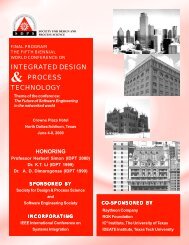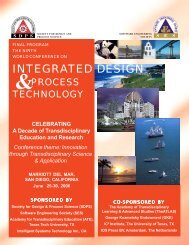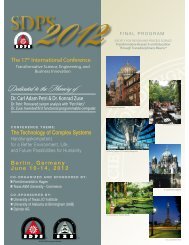IDPT(SDPS) 2008 Asia University
IDPT(SDPS) 2008 Asia University
IDPT(SDPS) 2008 Asia University
- No tags were found...
Create successful ePaper yourself
Turn your PDF publications into a flip-book with our unique Google optimized e-Paper software.
ing software engineering, it is time to review the foundations aswell as the impact of these software technologies on society – Thisis the nature of Software 2.0 Workshop. The face of software, whichis fundamentally an abstract design, is permanently changing, togetherwith the processes of software development and engineering.More than four decades passed since Shannon’s MIT talk and almosta decade passed since the great mentor Herb Simon’s <strong>SDPS</strong>-<strong>IDPT</strong> talk. It is much clear today that “collection, transmission, andprocessing of information” is the most fundamental scientific problemwith far reaching consequences into physical and biologicalsciences and engineering. Furthermore, as Herb Simon indicatessoftware development and engineering sits at the heart of that problem.Central techniques and methods of software engineering allowus to design and build very small-scale as well as very largescalesystems all the way to the “engineering of enterprises” of thefuture. Furthermore, deeper understanding of the fundamentalmechanisms of abstract software and algorithm construction allowsus to conceive and build spatially small but computationallyintensive nano-technology and potentially even quantum devices.In doing so, we are redefining the boundaries of classical engineeringand introducing far more levels of abstraction into the humanactivity called “engineering.” The key technology redefiningengineering is software technology and the engineering of it issoftware engineering. That is why; we like to call software engineeringthe discipline of 21 st century and the first transdiscipline.You are all invited to join to celebrate the successes of this abstracthuman activity called “software” and it is far reaching consequences.PANEL-IV KEYNOTE SPEAKERFriday, June 6, 9:00-9:30 amRoom: A101Friday, June 6, <strong>2008</strong> 9: 00 am - 9: 30 amRoom: Conference CenterDr. Jeffrey J.P. TsaiFounding President<strong>Asia</strong> <strong>University</strong>Taichung, TaiwanPANEL-IVDISTINGUISHED PANELISTSFroday June 6, 9:30 am-12:30 pmRoom: A101Dr. Peter ChenFoster DistinguishedChair ProfessorLSU, Baton Rouge, LA, USAholds the position of M. J. Foster Distinguished Chair Professor ofComputer Science since 1983. Prof. Peter Chen received his Ph.D.from Harvard <strong>University</strong> and has held regular and visiting facultyappointments at MIT, UCLA and Harvard. He is the originator of theEntity-Relationship Model (ER Model), which serves as the foundationof many systems analysis and design methodologies, computer-aidedsoftware engineering (CASE) tools, and repository systemsincluding IBM’s Repository Manager/MVS and DEC’s CDD/Plus.Dr. Chen’s work is a cornerstone of software engineering, in particularComputer-Aided Software Engineering (CASE). In the late80’s and early 90’s, IBM’s Application Development Cycle (AD/Cycle)framework and DB2 repository (RM/MVS) were based on the ERmodel. Other vendors’ repository systems such as Digital’s CDD+were also based on the ER model. Prof. Chen has made significantimpact on the CASE industry by his research work and by hislecturing around the world on structured system development methodologies.Most of the major CASE tools including Computer Associates’ERWIN, Oracle’s Designer/2000, and Sybase’sPowerDesigner (and even a general drawing tool like Microsoft’sVISIO) are influenced by the ER model.Dr. Kane KimDirector, Dream Laboratory<strong>University</strong> of California, IrvineCA, USAK. H. (Kane) Kim is Professor of Computer Engineering and ComputerScience at the <strong>University</strong> of California, Irvine, USA. He receivedan M.A. degree from the Computer Science Department atthe <strong>University</strong> of Texas at Austin in 1972 and a Ph.D. degree fromthe Computer Science Division at the <strong>University</strong> of California, Berkeley,in 1974. He has been building up a research laboratorynamed the DREAM (Distributed Real-Time Ever-AvailableMicrocomputing) Lab during the past twenty two years (http://dream.eng.uci.edu ).He is the principal originator of the TMO (time-triggered messagetriggeredobject, also called RTO.k) programming scheme, theDistributed Recovery Block (DRB) scheme, and several other fundamentaldependable computing approaches. Dr. Kim is a recipientof the 1998 IEEE Computer Society¡¯s Technical AchievementAward and the 2004 IEEE Computer Society¡¯s Tsutomu KanaiAward for his contributions to the scientific foundation of both realtimefault-tolerant computing and real-time object-/component-orienteddistributed computing. In 2007, he received the Korean OverseasCompatriots Award in the area of Science & Technology fromthe Korean Broadcasting System.Dr. Kim is a fellow of IEEE (elected in Fall 1988), a fellow of <strong>SDPS</strong>and a member of the IFIPWG 10.4 on Dependable Computing. Heserved as the Chairman of the IEEE Computer Society¡¯s TechnicalCommittee on Distributed Processing during 1984-86 andhosted several IEEE conferences. He also served as a member ofthe founding editorial board for the IEEE Transactions on Paralleland Distributed Systems during 1989¡©1994. In 1983, he was oneof the two co-founders of KOCSEA (Korean Computer Scientists &Engineers Association in America) and during 2005 - 2006, heserved as the president of KSEA (Korean-American Scientists &Engineers Association).








